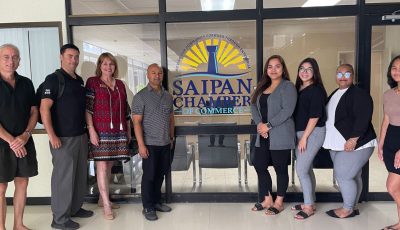An education plan for CW transition
After reading the article on the CW transition it reminded me of my pleas and warnings that date back to 2001 when I first introduced the idea that the CNMI needed to develop a public service program to transition our youth into the workforce. Now here we are 14 years later and finally someone realized we needed our education system to be in the forefront for training our future workforce. I have often been ahead of the times on issues and I guess that is why the powers that be never get it until it is too late. After 14 years the CW transition issue has now become a reality that we must address, which reminds me of one of my daughters when she was in high school and asked me, “Dad, why do we have a government that only does something when they have to and not when they are supposed to?” Children can even see our lackadaisicalness that is keeping us behind the times, which is the main reason they are leaving for the mainland!
I can remember over a decade ago when the CW transition issue first evolved and I was being interviewed with Dr. Sablan for the Commissioner of Education job and I told the Board of Education in that interview that if I were commissioner I would make sure that PSS would lead the CNMI’s effort to transition our local workforce with as many locals as possible. I also mentioned the public service program that was researched-based and supported by a successful working model in the public schools and universities of Mexico. I was sent to Mexico by the U.S. Department of Education to do research that could help the CNMI but nobody in our leadership paid any attention to my research and warnings for the CNMI to prepare for the exit of the garment industry and to prepare for transitioning our workforce! This is exactly why I keep saying time is on my side because I keep trying to help the CNMI stay ahead of the times but the powers-that-be are keeping us behind the times, causing us to play catch-up with the times and the rest of American society and the world. Please stop putting critical issues on the back burner until the last minute and we are forced to do something by the feds. We put the wage issue and CW issue on the back burner and now the feds have moved in. We put Pagan and the potential billion-dollar pozzolan industry on the back burner and now the military has moved in. We are literally setting a clear pattern of waiting for the feds to force us to do things that we need to be doing on our own!
NMC and PSS are doing what they can but they need more funding and support to do more. PSS’ Cooperative Program is a good start but the base of the program needs to be expanded as we are only experiencing a 15-percent transition of high school students into the workforce when we need it to at least be 50 percent and higher. I’m sure 85 percent of our graduating students are not going to college, so what is happening to this 85 percent? My educated guess is that most of the 85 percent are moving or planning on moving to the mainland for a better job and a better life. Our true challenge is to sell the CNMI to our youth who are leaving as fast as they can, which is all the more reason we need a public service program approach to boost CNMI commitment among our youth and to transition our workforce with local students and adults.
The only way the CNMI can maximize our efforts to transition as many students into as many jobs as possible is through a united education venture between PSS, NMC, and the trade school in collaboration with all employers in the CNMI under a public service program. PSS and NMC are limited in the skills and professions they can teach but a public service program will allow for the instructions training and entry level certification of every job in the CNMI occupied by a CW worker. I wrote about the public service program in 2001 and just last year but hopefully now someone on the Hill, especially those in the education committees in both chambers, will listen. The public service program works just like a cooperative education program but on a bigger scale with bigger purposes. The two purposes of the public service program is to first promote citizenship and dedication to the CNMI among our youth and second to provide free training for future professionals and skill laborers to enter the workforce with guaranteed jobs in almost every field of potential employment.
Unlike the cooperative program that is inclusive of only a few jobs and employers, a public service program will be inclusive of all jobs and employers who have CWs by law. Any job that is presently being held by a CW will be subject to transition status, requiring the employer to accept and train PSS, NMC, or trade school students to take the place of CWs. All employers and CW jobs will be tracked and held accountable to the CNMI Department of Labor who will work with PSS, NMC, and the trade school to fill these positions with trainee(s). Government agencies and entities will also train students: Some examples, if a student wants to go into medicine or healthcare, they will do their community service at CHC or if they are interested in the environment, they will work at the Bureau of of Environmental and Coastal Quality, Public Works, or Parks and Recreation.
Every CW job will be addresses by NMC or PSS without the need to create an additional class and there will be no need for additional instructional staff as the students will be getting their “on-the-job education and training” at their designated workplace. The community service program will also diminish the financial burdens, with fewer staff requirements at PSS and NMC when students are at their work-sites. Students at PSS will be required to have as much as 900 hours of community service training for a vocational diploma and NMC students will be required 600 hours of community service. So if a student wants to be an engineer, nurse, electrician, accountant, educator or any professional, they will have the potential to earn at least 1,500 hours of on-the-job training upon graduation from PSS and NMC, which should be sufficient to replace almost any CW worker. But more than anything, the public service program guarantees most our students will have a job when they graduate, which is what is needed to inspire our youth to remain in the CNMI and work.
The public service program gives employers free labor that can easily improve and increase their production during the training period while students will get a free education and training in a job or career that they want to pursue after graduation—it’s a fair and profitable trade off for students and employers. There are only two challenges for PSS and NMC with one being federal laws regarding child labor that will require all students to “voluntarily” enter the program and donate their time as a volunteer with their parents’ approval, which should really be just a formality and not a challenge to the program. The other challenge will be the transportation of students to and from their workplace, which will require extending and manipulating the bus system, which can easily be done to a large degree as the buses are actually sitting idle most of the day anyway.
We no longer have the luxury of time to wait the five years for NMC and PSS to build, expand, and accommodate more of the workforce needs, and a public service program is probably our best method to boost our youths’ commitment to stay in the CNMI and to train most of them to transition into the workforce with guaranteed jobs and careers. A public service program is a simple solution to a complex CNMI issue if anyone on the Hill is listening and I will gladly help you in writing the necessary bill if asked.
Trying to force the trade school and NMC to work together is noble but HB 19-4 is illogical and insufficient to address all the transition needs for a number of reasons that were shared by NMC’s president. The Adult Basic Education Program at NMC should also be left alone as it is not about skills but basic educational needs. However, the CNMI needs a transition bill that will bring together the Department of Labor with all of our students and all the public and private education institutions to work with all employers of CWs in transitioning our workforce– a complete public service program. The trade school should also be given more financial subsidies from the government (CNMI and Department of the Interior) to address the “skills” needed by the adult population in our transition efforts.
Ambrose M. Bennett
Kagman, Saipan



























